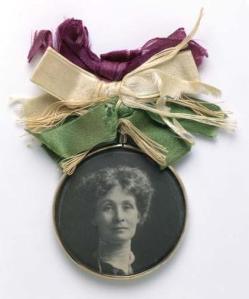
1908 – those hats!
The Edwardian era saw the rise of ready-to-wear clothes, was the height of the Belle Époque, and saw the influence on fashion of the suffragettes and dress reform reach its conclusion. As the Edwardian era progressed, the fashion houses of Paris began to favour a new silhouette, with a thicker waist, flatter bust, and narrower hips. By the end of the first decade of the 20th century, the most fashionable skirts cleared the floor and approached the ankle; allowing women more freedom of movement to go with their increasing social freedoms. The overall silhouette narrowed and straightened, beginning a trend that would continue into the years leading up to the Great War.

As the silhouette changed, it began to resemble the styles supported by the Dress Reform movement. As bustles disappeared, the need for a sturdy corset to support the structure of the bustle also fell from favour. In the USA, Mary Phelps Jacob designed the first ‘modern’ brassiere, that is recognized as the basis for our modern bras.She received the patent for her design in 1914. Bear in mind, there were other brassieres around at the time, but the modern bra was designed to be worn without an accompanying corset.

Suffragette Suit – the outfit most associated with the suffragette movement.
The Suffragette Suit is an outfit we now associate with the movement, but there was never an actual suffragette ‘uniform’. This suit was utilitarian, as working women couldn’t afford a special outfit for the movement. What they wore to rallies was simply what they wore on a daily basis, often with a green, white and violet ribbon or sash to proclaim their allegiance to the cause.

The shirtwaist outfit, sensible, neat and business-like.
Tailored clothes were worn for outdoor activities that didn’t involve a special sporting outfit. The shirtwaist was adopted for informal day wear and became the favoured clothing of the new breed of working women. As the bustles got smaller, the hats got bigger and bigger (see the three examples in the top image). The hats were HUGE! In America, the Gibson Girl was the ideal of style and beauty; tall and slender, yet with ample bosom, hips and buttocks.

The Classic Gibson Girl
The Lingerie Dress, a romantic style of dress adorned with embroidery, lace, pin tucks, ruffles and ribbons which was inspired by the Victorian chemise undergown, was the most popular fashion of the Edwardian era (hence the name). It could be worn as a wedding gown, a tea gown, to events just as promenades and races, and this versatility was due to the rapid changes fashion was imposing on the female silhouette. Lingerie gowns were worn with matching long gloves, lace parasols and elaborate summer hats. The example below is in plain white, but pastel colours and flowery prints were also favoured by this style. The widespread availability of manufactured lace made these dresses within the economic reach of the middle and working classes.

Lingerie dress of white embroidered net, English, circa 1900
This is the last instalment of ‘Understanding the Fashion Trends’. Seriously I could spend the rest of my life studying the historical fashions of the Victorian and Edwardian eras, but I am not that interested in fashion per se. Instead, I wanted to sketch the main fashion trends, because there were a lot of different trends during this historical period. As a Steampunk writer, research has to cover a lot of different topics.
This research helped give me a grasp of what was influencing the fashion trends. As certain fabrics and dyes became cheaper, it was economically important that the flood of fabric onto the market had a market. Styles that took a lot of fabric were an important boost to the manufacturing industries. So these fashions were influenced by the Industrial era, just as much as any other influence such as elegant designers and fashion houses of Barcelona and France.
My Steampunk protagonist is a girl with little interest in being a fashion icon. But that doesn’t mean her outfits aren’t influenced by the fashion trends of her era. And every item of clothing tells a reader something about your character.


Good stuff. I don’t do the fashion thing heavily either, but what I did do (in my main series set 1908-1909) was have the main character’s clothing reflect her state of mind.
She starts very restricted with corsetry, then switches to French fashion styles, then to Indian (her heritage), then back to restricted and finally back to indian.
Excellent use of clothing for characterisation. This is exactly the sort of thing I was getting at in the four articles.
And thank you for the compliment. Much appreciated.
Reblogged this on Cogpunk Steamscribe.